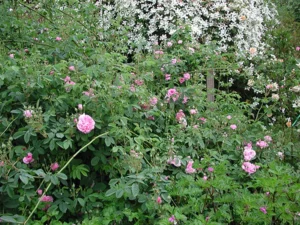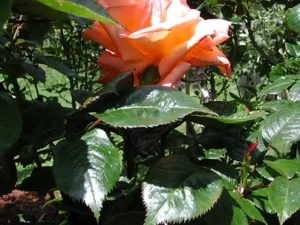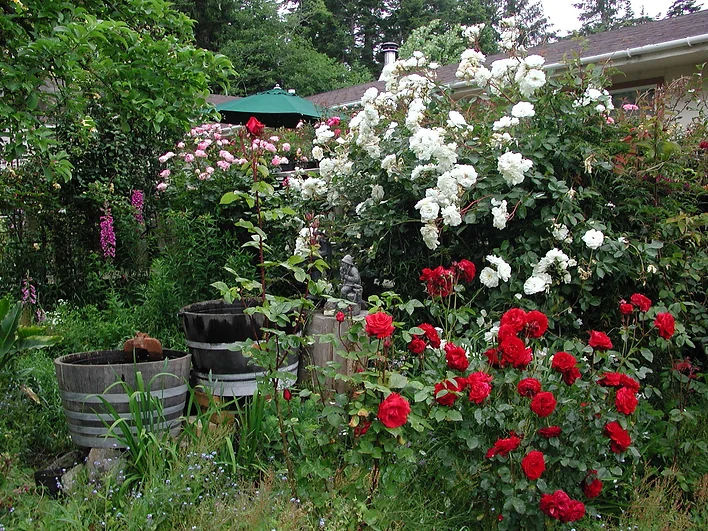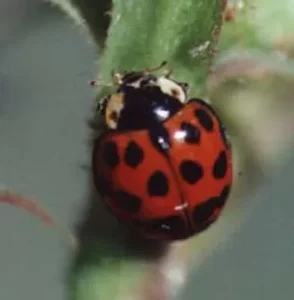by Pat Hamilton, Humboldt Rose Society, Master Rosarian until 2011
This is a 2006 AOM article

This year seems to be a continuation of one rainstorm after another; according to the weather bureau we have had 153 percent of normal rainfall. In our own garden December through the first week of February we had only six days that were free of some type of precipitation. This was followed by ten wonderfully warm spring days, hallelujah!!! We waited a couple of days until the ground didn’t suck at our shoes when we walked on it and then we finally planted our bare root roses that were setting in pots of potting soil because we had despaired of ever getting enough dry weather to put them in the ground. Needless to say, by then we were way behind on our pruning so we got at it as fast as we could go. Fortune smiled on us and we finished 350 roses before the rain made a three day return engagement. Next we were hit by a couple of weeks of hard freezes every night, this took care of a lot of new tender growth and some total classes of my perennials. Now we are on the next to the last day of February and we are being deluged with rain again.
There are benefits to having lots of rain, we don’t have to water at all yet….. I did get all the roses sprayed with Banner Maxx and Aliette so that should protect them against the worse fungi, mainly Downy mildew. We will just enjoy the sound of the rain hitting the windows and the porch roof, and think of the “HEROES” that will benefit from all this water. I am talking about the beneficial amphibians and insects which help us control the aphids, leaf hoppers and other chewing insects.

A good example of an amphibian is the Pacific Tree Frog. These little guys only grow to about two inches long and can vary in color from grey green, bronze to shades of brown. The one marking that they all have is a dark band running through their eyes and toward their front legs and a light underbelly. You can often hear their mating call or “rain call” on rainy days, or during mating season. Most people think of the ‘ribbit’ used by Hollywood as the standard frog call, it is however really the call of the Pacific Tree Frog. He is little but he is loud! These “HEROES” search out small insect pests in your garden and eat them. Adult frogs feed on flying and crawling insects and other invertebrates, they will stuff creatures almost as long as themselves in their mouths. ABOVE: Pacific Tree Frog.
These frogs like to lay their eggs in early March to May, in temporary ponds where predators such as Brown Salamanders and Bull Frogs do not live or lay their eggs. By choosing temporary ponds they reduce the number of predators that eat their tadpoles. Newly hatched tadpoles are about 1 cm long and grow quickly on a diet of algae and other water plants. Tree Frog tadpoles are grey green and their intestines can be seen through the skin on their stomach. Their tail fins are well-developed and set high on their body. Tadpoles eat a huge amount of food and leave a large amount of fertilizer.
When the tadpoles are about 4.5cm long they begin to grow back legs then front legs, and lose their tail. This is when they transform from a plant-eater to an insect-eater. At this stage they are only about the size of an adult’s “baby fingernail” but they are eating gnats, flies and mosquitoes.

Tree Frogs are mature adults at about one year old. They have sticky toe pads and can climb bark, leaves, and even glass. Here they like to climb in our roses and are found quite often residing within an over mature flower. We are always very careful not to accidentally toss one in the deadheading buckets. They also frequent the perennial and mixed gardens. The reason we have so many frogs around is that we have available wild areas (our old garden beds) as we never are caught up enough to tame that section and it seems to do all right without us. There is water available in low areas and our barrels that we sometimes use as fountains. The only drawback to the barrels is that when we see a bunch of frog eggs and tadpoles we know it will be pretty late in the summer before we can start our pump and fountain.
The Pacific Tree Frog really likes our rainy weather. Judging from the amount of “rain calls” we have been hearing, we will really have to be careful when we deadhead. These frogs are just one of the many reasons we don’t have to spray with Orthene 97W, however I keep it in my arsenal just in case!

Another “HERO” that is an insect which needs water is the Dragonfly. They deposit their eggs directly onto the surface of the water or into mud at the water’s edge. Their larvae are aquatic and breathe through gills. Their chief predators are fish and frogs while their main source of food is fish-spawn, tadpoles and the larvae of smaller insects. The larval stage can vary in duration from about three months to four or more years.
Dragonflies are fast-flying, four-winged insects with long bodies and enormous eyes. The adult dragonfly has the biggest eyes in the insect world and they are capable of detecting movement up to 15m away! These fascinating and colorful creatures are among the fastest and oldest insects in the world. Their fossilized remains show that they were already here on earth 300 million years ago! Dragonflies are not difficult to separate from other orders of insects: adults have a pair of prominent compound eyes that take up most of the head, a contracted thorax bearing, as well as the usual three pairs of legs, two pairs of large, delicate, membranous wings, and a long, slender abdomen. Dragonflies exhibit voracious appetites, feeding exclusively on small animal matter. Contrary to general belief, they CANNOT sting – nor can they harm humans in any other way! Adult dragonflies that survive the vulnerable period between commencement of emergence and successful maiden flight have an average life expectancy of 4-6 weeks.

We count ourselves very lucky to be blessed with numerous amounts of these. We have Dragonflies who are among the most beautiful insects we have ever seen. They have all the colors of the rainbow, we usually see bright red, blue, yellow and green ones on our bushes, or hovering above waiting to dart upon some unsuspecting flying insect. Dragonflies are formidable hunters as they are very well aerodynamically designed. I love to watch the way they hover and dart.
We must attribute our many Dragonflies to our deep water tank which has been converted to a fish pond, and the many spring-fed ponds in our wooded acre along Strawberry Creek on the back of our property.
I would be remiss if I did not include one more insect which is very common around here and is very helpful in controlling soft bodied insects and caterpillars! For many years I killed these insects every time I saw them as I thought they were ugly and therefore bad. I am talking about ground beetles.
There are about 2,500 known species of ground beetles in North America. These active insects are usually found on the ground under rocks, logs, leaves, bark, decomposing wood and other debris on the ground (mulch). When disturbed, beetles run rapidly but seldom fly. Most hide during the day and feed at night. Both adults and larvae are considered beneficial since they feed on larvae of many harmful insects. The life cycle of most species is usually completed within a year, although adults may live 2 to 3 years or longer. Some adults are attracted to lights and will feed on the crushed remains of their own kind that have been stepped on or run over. Many ground beetles exude or expel foul-smelling secretions that are used to repel their enemies. Some feed on snails and slugs. They will also climb plants to find prey, but because of their nocturnal habits most gardeners do not notice this activity.
I don’t know whether it is the wet weather or the new mulch (shredded redwood bark) that we added to most of the flower beds last year, but we have a plethora of ground beetles. I don’t expect to kill a one!

A partial list of other “Good Guys” in the garden that help you to grow roses with out insect sprays follows:
Lady beetles, one of the top daytime predators. Most gardeners are familiar with at least the adult stage. However the larvae are also predaceous and feed on pesky pests such as aphids, scales, mites and insect eggs. These are well worth protecting.
Next we have a couple of spiders, one a night predator and the other a day time hunter. The wolf spider is commonly found on the ground, where it feeds on numerous types of small insects – its population will increase if you provide it with plenty of cover such as mulch. Wolf spiders do bite so don’t handle them. The crab spider gets its name from the way it holds its legs…out to the side like crab legs. These spiders climb flowers and plants to find a good place to sit and wait for prey. Often these spiders are highly camouflaged looking like the flower they inhabit. These spiders eat various small insects and are quite capable of capturing flying insects that visit the flowers. You will see these in many light colors, we have them in white to shades of yellow and orange.
I would be remiss if I did not list the little wren in my list of predators. I know she is a bird but I have seen one with a beak full of aphids headed for her nest. I have watched one hopping down a climbing rose cane picking up every aphid as she hopped. The only thing I would like better than to see a wren nest in my yard would be to see two or three nest there.
With all the rain we have had already, one would think we were due for some more sunshine, but the weatherman says we are due for a week of rain and showers.
All photos by Pat Hamilton unless otherwise stated.




























































